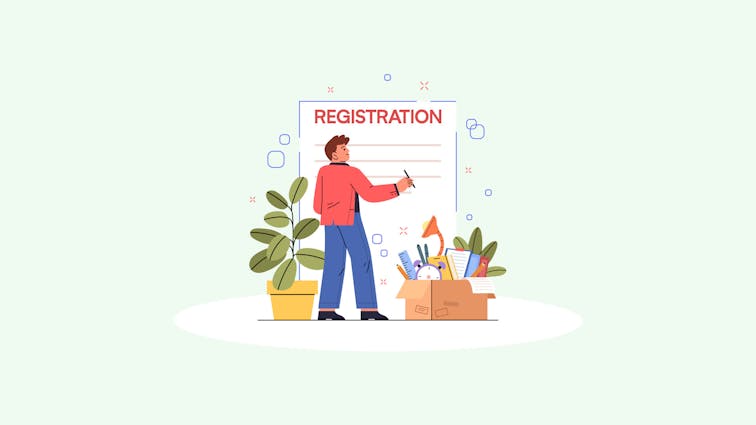
Beginner's Guide: Starting Your Own Ecommerce Business in India
Do you want to start a business that you can run from the comfort of your home?
Have you always wanted to be a successful entrepreneur? Do you want to boost your sales by joining the ecommerce bandwagon? If your answer to any of these questions is yes, then you’re in the right place!
Many people think about starting a business and coming up with ideas but don’t follow through because they feel that going online takes too much time and effort.
Thankfully, it is easier than ever to start an ecommerce business with the help of the Aasaan mobile app.
In this article, we will show you how you can start an eCommerce business and use the power of the internet to your advantage without any hassles.
How to start an e-commerce business in India: The step-by step Guide

1. Understanding the Ecommerce Landscape
A. The current state of ecommerce in India
Ecommerce in India is currently in a state of rapid growth.
With the increase in internet penetration and the availability of affordable smartphones, more and more people are turning to online shopping.
This trend is not just limited to urban areas but is also seen in rural regions, indicating a dynamic growth in access to the internet and online shopping platforms.
Some of the ecommerce stats in India for 2025 are:
- The Indian eCommerce market is expected to generate a revenue of US$71,292.1 million by 2023, with a compound annual growth rate (CAGR) of 13.9% from 2023 to 2027.
- India is expected to have over 907 million internet users by 2023, which accounts for ~64% of the total population of the country.
- The number of annual online shoppers in India is projected to reach 329 million by 2023.
- The online retail industry in India is estimated to have a market size of $60 billion by 2023.
B. The potential for growth and profitability
The potential for growth and profitability in the Indian ecommerce sector is immense.
With the projected increase in internet users, the customer base for online businesses is set to expand significantly.
Moreover, the ongoing digital transformation in the country is expected to further fuel this growth.
2. Crafting Your Business Plan
A. Importance of a business plan
A business plan is crucial for the success of any business, and ecommerce is no exception.
It serves as a roadmap, guiding you through the different stages of your business.
It helps you set goals, plan your strategy, and identify potential challenges.
B. Components of an ecommerce business plan
An ecommerce business plan should include an executive summary, a company description, a market analysis, organization and management details, a description of your service or product line, marketing and sales strategies, and financial projections.
C. Finding the right business model
Choosing the right business model is key to the success of your ecommerce venture.
Whether it’s B2B (Business to Business), B2C (Business to Consumer), C2C (Consumer to Consumer), or C2B (Consumer to Business).
The choice depends on your business goals, target audience, and the type of products or services you intend to sell.
3. Market Research and Finding Your Niche

A. The importance of market research
Market research is the backbone of any successful business. It helps you understand your target audience, their needs, preferences, and behaviors.
This information is crucial in making informed decisions about your product offerings, pricing, marketing strategies, and more.
Without proper market research, you’re essentially flying blind.
B. Tools and techniques for conducting market research
There are various tools and techniques available for conducting market research. These include:
- Surveys and Questionnaires: These are great for gathering quantitative data and can be distributed via email, social media, or online platforms like SurveyMonkey.
- Interviews and Focus Groups: These provide qualitative data and offer deeper insights into customer attitudes and behaviors.
- Observation: This involves watching consumers in action, either in person or through digital tools like website analytics.
- Competitor Analysis: This involves studying your competitors to understand their strategies and identify gaps in the market.
C. Identifying and understanding your niche
Your niche is the specific segment of the market that your business caters to.
Identifying and understanding your niche is crucial for the success of your ecommerce business.
It allows you to focus your efforts on meeting the specific needs of a targeted group of customers.
For example, if you’re selling handmade vegan soaps, your niche could be environmentally-conscious consumers looking for cruelty-free personal care products.
4. Branding Your Ecommerce Business
A. The importance of branding
Branding is more than just a logo or a tagline; it’s the overall image and perception that people have of your business.
A strong brand can set you apart from your competitors, build customer loyalty, and drive business growth.
B. Creating a unique brand identity
Your brand identity is the visual representation of your business and includes elements like your logo, color scheme, typography, and imagery. Creating a unique brand identity involves:
- Understanding Your Audience: Your brand identity should resonate with your target audience. Understand their preferences and tailor your brand identity to appeal to them.
- Defining Your Brand Personality: Is your brand fun and quirky, or serious and professional? Your brand personality should be reflected in your brand identity.
- Consistency: Ensure that your brand identity is consistent across all platforms and touchpoints. This helps to build recognition and trust.
C. Designing the perfect logo
Your logo is often the first thing people notice about your brand, so it’s important to get it right.
A good logo is simple, memorable, and effectively communicates your brand values.
Consider hiring a professional designer or using online tools like Canva or Adobe Illustrator to create your logo.
Remember, building a successful ecommerce business in India involves understanding the market, identifying your niche, and creating a strong brand.
With the right approach, you can tap into the booming ecommerce market and create a thriving business.
5. Legal Formalities and Registration

A. Registering your ecommerce business in India
Starting an ecommerce business in India involves several legal formalities. First, you need to decide on the legal structure of your business.
This could be a Sole Proprietorship, Partnership, Limited Liability Partnership (LLP), or Private Limited Company.
Each structure has its own advantages and requirements, so it’s important to choose the one that best suits your business needs.
Once you’ve decided on the structure, you can register your business with the Ministry of Corporate Affairs (MCA).
B. Understanding legal requirements
There are several legal requirements you need to be aware of when running an ecommerce business in India.
These include complying with the Information Technology (IT) Act 2000, the Consumer Protection Act 2019, and the Indian Contract Act 1872.
You also need to understand the tax implications of running an ecommerce business, including Goods and Services Tax (GST) registration and compliance.
C. Opening a bank account for your business
Once your business is registered, you’ll need to open a bank account in the name of your business.
This helps to keep your personal and business finances separate, making accounting and tax filing easier.
6. Building Your Ecommerce Website
A. Choosing a domain name
Your domain name is your website’s address on the internet and is a crucial part of your online identity.
Choose a domain name that is short, easy to remember, and reflects your brand.
B. Selecting a hosting provider
A hosting provider is a service that stores your website on servers and makes it accessible to users on the internet.
When choosing a hosting provider, consider factors like uptime, speed, customer support, and scalability.
C. Designing your ecommerce store
The design of your ecommerce store plays a crucial role in attracting and retaining customers.
Ensure your website is user-friendly, visually appealing, and reflects your brand identity.
You can use ecommerce platforms like Aasaan, Shopify or WooCommerce, which offer customizable templates, or hire a web designer to create a custom design.
D. Securing your website with SSL Certificate
An SSL (Secure Sockets Layer) certificate encrypts data transferred between your website and your users, protecting sensitive information like credit card numbers and passwords.
Having an SSL certificate is crucial for an ecommerce website and can also improve your website’s ranking on search engines.
7. Sourcing Products and Finding Suppliers

A. Different methods of sourcing products
There are several methods of sourcing products for your ecommerce store. These include:
- Manufacturing: This involves creating your own products to sell.
- Wholesaling: This involves buying products in bulk from manufacturers and selling them at a markup.
- Dropshipping: This involves selling products that are fulfilled by a third party.
B. How to find and vet suppliers
Finding reliable suppliers is crucial for your ecommerce business.
You can find suppliers through online directories, trade shows, or networking. When vetting suppliers, consider factors like their reliability, product quality, pricing, and communication skills.
Remember, starting and running an ecommerce business involves several steps, from understanding legal requirements to building a secure and user-friendly website.
With careful planning and execution, you can create a successful ecommerce business in India.
8. Payment Methods and Logistics
A. Selecting payment methods
When it comes to payment methods, you want to give your customers options. Here are a few popular ones in India:
- Credit/Debit Cards: Almost everyone has one. Make sure your ecommerce store accepts Visa, MasterCard, and other major cards.
- Net Banking: Many prefer to pay directly from their bank account.
- Mobile Wallets: With the rise of Paytm, Google Pay, and others, mobile wallets are super popular.
- Cash on Delivery (COD): Some customers feel more secure paying with cash upon receiving the product.
B. Understanding logistics and shipping
Shipping can make or break your ecommerce business. Here’s what you need to know:
- Choose a Reliable Courier: Partner with courier services known for timely and safe deliveries.
- Shipping Costs: Decide whether you’ll offer free shipping, flat-rate shipping, or variable rates based on distance or weight.
- Tracking: Provide customers with tracking information so they know when to expect their delivery.
9. Marketing and Customer Acquisition

A. Digital marketing strategies for ecommerce
To get the word out about your ecommerce store, you need a solid digital marketing strategy. Here are some tactics:
- SEO: Optimize your store for search engines to get free, organic traffic.
- Social Media Marketing: Use platforms like Instagram, Facebook, and Twitter to build a following and promote products.
- Email Marketing: Collect emails and keep your customers engaged with newsletters and promotions.
B. Customer acquisition techniques
Getting new customers is an art. Here are some techniques:
- Referral Programs: Encourage your current customers to refer friends.
- Influencer Collaborations: Partner with social media influencers to get your products in front of a larger audience.
- Discounts and Promotions: Everybody loves a good deal. Offer first-time buyer discounts.
10. Scaling Your Ecommerce Business
A. Strategies for scaling
You’ve got your ecommerce store up and running. Now it’s time to scale. Here’s how:
- Expand Your Product Range: Start with a few products and gradually add more as you grow.
- Go Global: Start selling internationally.
- Optimize Your Supply Chain: As you get more orders, you’ll need to streamline your supply chain.
B. Monitoring and optimizing performance
Keep a close eye on how your store is performing. Use tools like Google Analytics. Monitor sales, website traffic, and customer engagement.
Use this data to optimize your store, products, and marketing campaigns.
And there you have it! Starting an ecommerce business in India is no small feat, but with dedication, insight, and the right strategies, you can build a successful online store.
Keep your customers at the heart of everything you do and never stop optimizing.
Please note that this information is based on general industry knowledge and may not reflect the most recent trends or data.
Always conduct your own research and consult with professionals in your field.
Where To Start a Business?
Starting an online business can be confusing. It involves paying exorbitant amounts to web developers and social media handlers, and the initial costs have deterred many offline businesses from going online. Then comes tracking inventory, managing orders, and contacting customers.
But what if we told you that you could do all these things sitting on your couch with your phone in your hand? That’s right - Aasaan makes it easy for businesses to create an online presence and boost their sales through the power of the internet.
These are the first things that you must do to start an eCommerce business through Aasaan -
1. Sign Up:
Firstly, you need to create an account on the Aasaan app and tell us about yourself and the brand that you are trying to establish.
2. Build Your Catalogue:
Once you complete the sign-up process, you should move to our catalog builder. The catalog builder allows you to add products to your catalog along with images, inventory, quantity, and product description.
3. Build your brand:
You can choose a logo that suits your brand, and pick the appropriate business category for your products or services to make your niche known to the world.
4. Make Your Website:
Aasaan makes creating stunning, professional business domains a breeze for you. There is no need for you to give your inheritance away to web designers now that we are here!
Extra Tips:
Your brand name should be unique and short to avoid confusion and disinterest because people will not feel attracted to your brand if they cannot pronounce your brand name. Avoid naming your brand something that is not relevant to the product or services you offer to avoid any misinformation surrounding your brand.
How To Sell?
Now that you have taken your business online, you must choose how and where you want to be selling your products. Here are some tips that will help you make your products fly off your shelves:
- Be Open To New Ideas:
You should always be open to new ideas for products and services that you can introduce through your brand.
Just because you sell one type of product offline does not mean that you cannot diversify into other fields online either.
You should be analytical about trends, develop things in demand in the foreseeable future, and capitalize on such opportunities. - Sell On Social Media:
Most of the big businesses today realize the power that social media holds, and as a result, they have been showing a massive social media presence.
There is no reason you should not take advantage of this opportunity to grow your business. The Aasaan app allows you to sell your products on WhatsApp, Facebook, and Instagram. You can easily accept orders, and share coupons and updates with your customers on these platforms. - Choose The Easy Way:
Aasaan allows you to set up your website, manage orders and shipments, as well as manage your inventory.
How To Market?
Starting an ecommerce business requires a marketing strategy that can quickly build your customer base or boost your existing one. Through Aasaan, you can use the power of Search Engine Optimisation (SEO) to your advantage and organically grow the traffic to your website.
You can also promote your website on your social media handles to further your growth. You should actively post updates about your brand and products to increase your reach and customer involvement. Introduce offers that entice new customers to buy your product or reward existing customers to return to you.
Aasaan allows you to analytically view your brand’s inflows and outflows simply through the dashboard feature of the app.

How To Manage Your Ecommerce Business?
Once you finish setting up and establishing your brand, you need to manage it in the future. Typically, managing a business is a very time-consuming job where you must stay in the office and take care of orders, shipping, payments, and so on.
Thanks to the Aasaan app, you can easily do all those things through your smartphone. You can even manage store hours, get notifications about new orders, and check delivery details and payment information on the move.
You should consider improving your networks by optimizing your relations with suppliers and customers, asking for employee feedback, and trying to improve based on that, analyzing your employees’ efficiency, and coming up with ways to boost that efficiency such as bonuses and other rewards for top employees.
Optimize your product descriptions, keeping SEO in mind as doing that will increase traffic on your website tremendously. You should keep a close eye on the time that your products take to get delivered to the consumer and try to reduce the delivery times and logistics costs to increase revenues and boost efficiency along with customer satisfaction.
Conclusion
Starting an ecommerce business in India is a promising venture, given the rapid growth of online shopping in the country.
However, like any business, it requires careful planning and execution. From understanding the ecommerce landscape and crafting a business plan to building your ecommerce website and scaling your business, each step plays a crucial role in your business’s success.
Remember, the key to a successful ecommerce business is to keep your customers at the heart of everything you do.
Understand their needs, provide great products, and offer excellent customer service. With dedication, hard work, and the right strategies, you can build a successful and profitable ecommerce business in India.
So, are you ready to start your ecommerce journey? Go ahead, the world of ecommerce awaits you!
Frequently Asked Questions:
1. How much does it cost to start an ecommerce business in India?
The cost of starting an ecommerce business in India can vary greatly depending on several factors, such as the type of products you plan to sell, the ecommerce platform you choose, marketing expenses, and more. On average, you can expect to spend anywhere from INR 10,000 to INR 50,000 to get started.
2. Is ecommerce profitable in India?
Yes, ecommerce can be highly profitable in India. The country has seen a significant rise in online shopping, and this trend is expected to continue. However, like any business, the profitability of an ecommerce business depends on various factors, including the products you sell, your pricing strategy, and how effectively you manage your operations and marketing.
3. How do I start an ecommerce business?
Starting an ecommerce business involves several steps, including conducting market research, finding a niche, creating a business plan, registering your business, setting up your online store, sourcing products, and marketing your business. It’s important to thoroughly research and plan each step to increase your chances of success.
4. How much do I need to start an ecommerce business?
The amount you need to start an ecommerce business can vary widely depending on your business model, the products you plan to sell, and the ecommerce platform you choose. On average, you can expect to spend anywhere from INR 10,000 to INR 50,000 to get started. However, keep in mind that you’ll also need a budget for ongoing expenses like inventory, marketing, and website maintenance.








